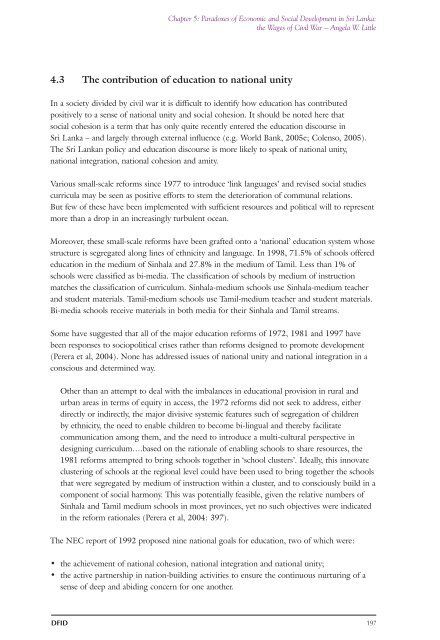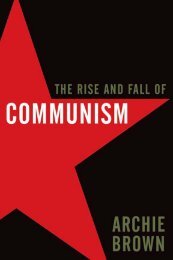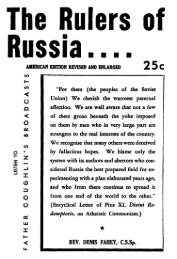education-dev-global-era-69
education-dev-global-era-69
education-dev-global-era-69
You also want an ePaper? Increase the reach of your titles
YUMPU automatically turns print PDFs into web optimized ePapers that Google loves.
Chapter 5: Paradoxes of Economic and Social Development in Sri Lanka:the Wages of Civil War – Angela W. Little4.3 The contribution of <strong>education</strong> to national unityIn a society divided by civil war it is difficult to identify how <strong>education</strong> has contributedpositively to a sense of national unity and social cohesion. It should be noted here thatsocial cohesion is a term that has only quite recently entered the <strong>education</strong> discourse inSri Lanka – and largely through external influence (e.g. World Bank, 2005e; Colenso, 2005).The Sri Lankan policy and <strong>education</strong> discourse is more likely to speak of national unity,national integration, national cohesion and amity.Various small-scale reforms since 1977 to introduce ‘link languages’ and revised social studiescurricula may be seen as positive efforts to stem the deterioration of communal relations.But few of these have been implemented with sufficient resources and political will to representmore than a drop in an increasingly turbulent ocean.Moreover, these small-scale reforms have been grafted onto a ‘national’ <strong>education</strong> system whosestructure is segregated along lines of ethnicity and language. In 1998, 71.5% of schools offered<strong>education</strong> in the medium of Sinhala and 27.8% in the medium of Tamil. Less than 1% ofschools were classified as bi-media. The classification of schools by medium of instructionmatches the classification of curriculum. Sinhala-medium schools use Sinhala-medium teach<strong>era</strong>nd student materials. Tamil-medium schools use Tamil-medium teacher and student materials.Bi-media schools receive materials in both media for their Sinhala and Tamil streams.Some have suggested that all of the major <strong>education</strong> reforms of 1972, 1981 and 1997 havebeen responses to sociopolitical crises rather than reforms designed to promote <strong>dev</strong>elopment(Per<strong>era</strong> et al, 2004). None has addressed issues of national unity and national integration in aconscious and determined way.Other than an attempt to deal with the imbalances in <strong>education</strong>al provision in rural andurban areas in terms of equity in access, the 1972 reforms did not seek to address, eitherdirectly or indirectly, the major divisive systemic features such of segregation of childrenby ethnicity, the need to enable children to become bi-lingual and thereby facilitatecommunication among them, and the need to introduce a multi-cultural perspective indesigning curriculum….based on the rationale of enabling schools to share resources, the1981 reforms attempted to bring schools together in ‘school clusters’. Ideally, this innovateclustering of schools at the regional level could have been used to bring together the schoolsthat were segregated by medium of instruction within a cluster, and to consciously build in acomponent of social harmony. This was potentially feasible, given the relative numbers ofSinhala and Tamil medium schools in most provinces, yet no such objectives were indicatedin the reform rationales (Per<strong>era</strong> et al, 2004: 397).The NEC report of 1992 proposed nine national goals for <strong>education</strong>, two of which were:• the achievement of national cohesion, national integration and national unity;• the active partnership in nation-building activities to ensure the continuous nurturing of asense of deep and abiding concern for one another.DFID 197





